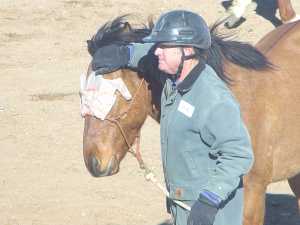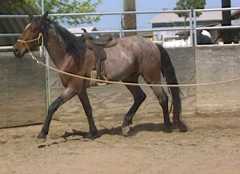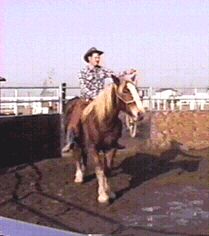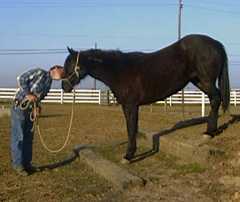- Desensitizing (Confidence Building.)
 Horses will try to train us to avoid things that they fear or don't like. Some horses
are really good at this and over time their humans avoid windy days, water, shiny
objects, plastic and a whole slew of other disturbing stimuli. Desensitizing is an
element where the handler has to combine awareness, imagination and
basic gentling strategies in order to improve the horse's confidence. There are no
fixed formulas for desensitizing, mainly proven principles.
Horses will try to train us to avoid things that they fear or don't like. Some horses
are really good at this and over time their humans avoid windy days, water, shiny
objects, plastic and a whole slew of other disturbing stimuli. Desensitizing is an
element where the handler has to combine awareness, imagination and
basic gentling strategies in order to improve the horse's confidence. There are no
fixed formulas for desensitizing, mainly proven principles.
Whether desensitizing a horse by means of direct contact with a scary object or through
the horse solving puzzles in the Horse Course, we have to engage the horse's "left
brain" and minimize the amount of mental energy he invests in his "right brain." When
desensitizing by means of direct contact we want to as much as possible maintain some
touch contact in the horse's safe zones with our free hand or, if that isn't feasible,
Take and Give and ask the horse to maintain a relaxed head posture. If the horse
is confronting scary obstacles we'll approach the obstacles with the attitude that they
are puzzles to solve, not confrontations. We'll encourage the horse to approach, allow
him to retreat if he needs to consider things, but not let him leave the obstacle.
By reinforcing communication and safety through touch and/or our body language and
giving the horse time to process the situation (but not so much time that he
gets bored and "checks out") the horse will usually accept the unsettling issue on
his own and the benefits gained from our desensitizing efforts are more likely to last
after the exercise has been completed.
If a horse is having a particular issue with something, seems to be headed deep into
right brain mode, and when it is safe and practical to do so, we may engage in a little
"Mouth Magic" for a few seconds. This sensation will usually encourage the horse to
unlock his jaw and bring his focus back to the handler. It doesn't mean that the horse
might not also be simultaneously focused on whatever is scaring him but mouth and
tongue contact can help reconnect the horse with his handler. Later a skilled rider
can emulate Mouth Magic by lightly feathering the reins (which feathers the bit). If
the horse has been conditioned to respond favorably to Mouth Magic, the rider has a
better chance of getting the horse mentally reconnected without having to resort to
"heavy hands" (hauling the horse around by the bit.)
- Ballet on the Ground.
 Ballet on the ground involves sending the horse out as if to longe in a circle, then when
he reaches the end of the line, bringing him back with a tug similar to asking for a
Wind Down. When the horse comes back in, we change rope hands and with our free
hand we wave the horse off (if necessary) so that the horse passes in front of us in
the opposite direction.
Ballet on the ground involves sending the horse out as if to longe in a circle, then when
he reaches the end of the line, bringing him back with a tug similar to asking for a
Wind Down. When the horse comes back in, we change rope hands and with our free
hand we wave the horse off (if necessary) so that the horse passes in front of us in
the opposite direction.
The maneuver is repeated when the horse again hits the end of the rope and we get the
horse to make a mirror image of the first loop. The total movement should roughly form
a figure eight laid on its side (with one loop to our left and the other loop to our
right.) This is a figure that we also call a "bow tie."
We like to have our horses proficient in this movement since it involves changes of
direction, turns over the forehand and turns over the haunches in a continuous sequence
of turns. The horse can work on his balance and follow-through while the handler works
on his/her technique, making the figure smoother and more consistent.
As we refine Ballet on the Ground, we should see the horse visibly shift his weight
from the forehand to the hindquarters and back as he switches from one part of the
maneuver to the other. For example, when the horse begins the turn at the end of
the lead he's going to disengage. When he ends the turn and starts out in the opposite
direction he should shift his weight back and swing his front end away with a turn
over the haunches. (We can adjust the shape of these loops once the horse starts to
understand the idea in order to emphasize these changes of balance. We can also employ
aids that range from shaking the rope to directing the horse with a flag or stick.)
- In the Saddle.
 If we were to take an unknown vehicle out onto the highway we would make some subliminal
checks when we first started out. If the steering or brakes didn't feel quite right,
we'd probably check things out a bit more closely before going out into high speed
traffic. Such logic is even more
important when getting up to ride a horse. Before things get busy there are a few
simple things we can do to make sure we have steering and speed control.
If we were to take an unknown vehicle out onto the highway we would make some subliminal
checks when we first started out. If the steering or brakes didn't feel quite right,
we'd probably check things out a bit more closely before going out into high speed
traffic. Such logic is even more
important when getting up to ride a horse. Before things get busy there are a few
simple things we can do to make sure we have steering and speed control.
We'll walk in a lazy circle. For this example, the circle will be clockwise. When the
horse is up to a reasonably lively walk we will take up the slack in the left (outside)
rein, lean slightly forward, slide our right hand down the right (inside) rein and draw
the horse's head around by pulling the rein back to our hip. (This movement should be
smooth, not a jerk, and be somewhat similar to what we did in the Wind Down from the
ground.)
As we feel a change in the horse's speed and his neck starts to bend, we'll feed some
slack to the left (outside) rein, shift in the saddle and bump the horse's right
(inside) side slightly behind the cinch with our right (inside) leg. This contact
should cause the horse to disengage. If the horse appears anxious we may scratch his
neck with our left (outside) hand for reassurance. As soon as the horse complies and
makes a turn over his forehand then we'll remove all contact and let him stop.
As soon as the horse has stopped, is relaxed and will softly give his head to the
side, we will resume the movement by
taking up the reins and shifting our weight back slightly (to which the horse should
instinctively also shift his weight back,) lay the left (outside) rein across the
horse's neck, and encourage the horse to step off to the right by extending our left
(outside) leg slightly forward of the cinch and gently bumping him to move forward and
to the right. If the horse doesn't instinctively shift his weight backwards, we may
ask for an actual step backwards before asking the front end to turn. This weight
shift is a key element in this maneuver.
These maneuvers can help develop reliable stopping and steering. We should point out
that as soon as the horse understands the exercise, the interval between stopping and
again starting should be varied. We don't want the horse to develop a habit of
stopping, then start out after a specific period of time that we have conditioned
through repetitive drills. He needs to wait until a clear cue is given by the rider
before stepping out.
- All of these exercises are designed to develop a light feel, balance and that all
important one rein stop.
- Exercises performed in one direction (e.g., clockwise) should also be performed in
the opposite direction (e.g., counter clockwise) until the horse is equally proficient
in both directions.
- Smoothness, finesse and use of the least aid necessary are more important than
speed.
- Additional appropriate aids such as flags, sticks, sticks with ropes, etc., can
be used as necessary when they help clarify the handler's intentions and when the
horse is not overly sensitive to their presence.
- When using the Seven Step Safety System to "pre flight" check your horse, make sure
that your horse is competent and relaxed in each step before proceeding to the next. If
your horse needs a little reinforcement on a step with which he is having some
difficulty, the time to take care of it is before things get "sensational" in the
saddle!
Please note that the intent of this feature is to illustrate the purposes and usefulness of ordered lists that we like for gentling and training horses. It is not our intention, nor do we have the space, to identify all of the potential techniques that can make these games successful or to try to teach various nuances involved. For more complete information on the Seven Step Safety System and related training concepts, please visit www.horsewhisperer.com.
More discussion on Frank's Seven Step Safety System can be viewed in
excerpts from Western Horseman (posted with permission of the author.)
Mustangs free running a pattern at a Frank Bell "Gentle Solutions" Clinic in Nevada

"Frank Bell" and "Gentle Solutions" are trademarks of Dances With Horses, Inc., Rexburg, ID.
This feature continues to The Seven Horseman's Survival Tips.
|


 Horses will try to train us to avoid things that they fear or don't like. Some horses
are really good at this and over time their humans avoid windy days, water, shiny
objects, plastic and a whole slew of other disturbing stimuli. Desensitizing is an
element where the handler has to combine awareness, imagination and
basic gentling strategies in order to improve the horse's confidence. There are no
fixed formulas for desensitizing, mainly proven principles.
Horses will try to train us to avoid things that they fear or don't like. Some horses
are really good at this and over time their humans avoid windy days, water, shiny
objects, plastic and a whole slew of other disturbing stimuli. Desensitizing is an
element where the handler has to combine awareness, imagination and
basic gentling strategies in order to improve the horse's confidence. There are no
fixed formulas for desensitizing, mainly proven principles.
 Ballet on the ground involves sending the horse out as if to longe in a circle, then when
he reaches the end of the line, bringing him back with a tug similar to asking for a
Wind Down. When the horse comes back in, we change rope hands and with our free
hand we wave the horse off (if necessary) so that the horse passes in front of us in
the opposite direction.
Ballet on the ground involves sending the horse out as if to longe in a circle, then when
he reaches the end of the line, bringing him back with a tug similar to asking for a
Wind Down. When the horse comes back in, we change rope hands and with our free
hand we wave the horse off (if necessary) so that the horse passes in front of us in
the opposite direction.
 If we were to take an unknown vehicle out onto the highway we would make some subliminal
checks when we first started out. If the steering or brakes didn't feel quite right,
we'd probably check things out a bit more closely before going out into high speed
traffic. Such logic is even more
important when getting up to ride a horse. Before things get busy there are a few
simple things we can do to make sure we have steering and speed control.
If we were to take an unknown vehicle out onto the highway we would make some subliminal
checks when we first started out. If the steering or brakes didn't feel quite right,
we'd probably check things out a bit more closely before going out into high speed
traffic. Such logic is even more
important when getting up to ride a horse. Before things get busy there are a few
simple things we can do to make sure we have steering and speed control.
